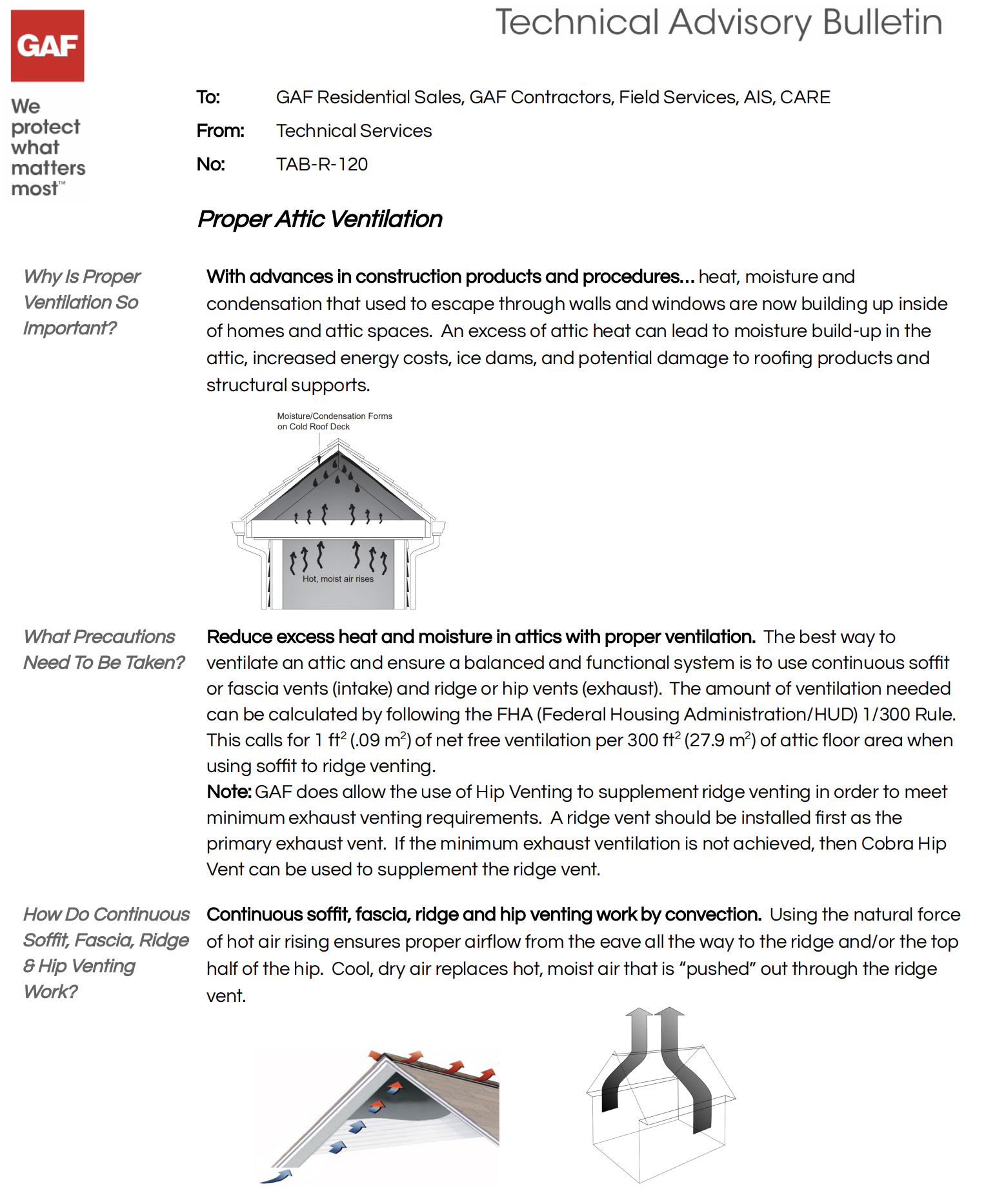Why Is Proper Ventilation So Important?
With advances in construction products and procedures, heat, moisture, and condensation that used to escape through walls and windows are now building up inside homes and attic spaces. Excess attic heat can lead to moisture build-up, increased energy costs, ice dams, and potential damage to roofing products and structural supports.
What Precautions Need to Be Taken?
Reducing excess heat and moisture in attics requires proper ventilation. The best way to ventilate an attic and ensure a balanced and functional system is to use continuous soffit or fascia vents (intake) and ridge or hip vents (exhaust).
Ventilation Calculation:
- The amount of ventilation needed can be calculated by following the FHA (Federal Housing Administration/HUD) 1/300 Rule. This calls for 1 ft² (.09 m²) of net free ventilation per 300 ft² (27.9 m²) of attic floor area when using soffit to ridge venting.
Supplemental Venting:
- GAF allows the use of Hip Venting to supplement ridge venting to meet minimum exhaust venting requirements. A ridge vent should be installed first as the primary exhaust vent. If the minimum exhaust ventilation is not achieved, then Cobra Hip Vent can be used to supplement the ridge vent.
How Do Continuous Soffit, Fascia, Ridge & Hip Venting Work?
These ventilation systems work by convection. Using the natural force of hot air rising ensures proper airflow from the eave to the ridge and/or the top half of the hip. Cool, dry air replaces hot, moist air that is pushed out through the ridge vent.
How to Avoid Attic Ventilation Problems
Install a Balanced Ventilation System:
- Ventilation systems such as soffit and ridge/hip vents must be balanced to work effectively. A properly balanced system provides for 50% of the airflow through the soffit and 50% through the ridge and/or the top half of the hip. The amount of ridge/hip (exhaust) ventilation should not exceed the amount of soffit (intake) ventilation.
Supplement with Hip Venting if Needed:
- If the length of available ridge is limited, supplement with venting hips. Cobra Hip Vents installed on the hips will help provide effective ventilation on roofs with little or no ridge area.
Avoid Multiple Vent Systems:
- Do not use multiple vent systems. If continuous soffit or fascia and ridge vents are used, power fans, roof louvers, static exhaust vents, and any other roof vents should be removed or disconnected, and gable vents should be closed. Mixing ventilation systems can result in reverse airflow, leading to water leakage into the attic.
Proper Use of Exhaust Vents:
- Do not utilize exhaust vents as intake. Roof louvers, ridge vents, or other static exhaust vents installed at or near the eave edge will not function effectively as intake ventilation.
Ventilated Roof Insulation Panels:
- In structures with little or no attic space, a Ventilated Roof Insulation Panel (vented nail base) can be installed to reduce heat drive into the living/condition spaces and exhaust excess moisture before it can condense in the roof deck or roofing system.
How Does Ventilation Affect Warranty Coverage?
GAF’s Shingle & Accessory Limited Warranty that covers manufacturing defects will remain in effect regardless of the ventilation used. However, any damage to the roofing system or the structure caused by inadequate ventilation is not covered by the warranty. The GAF Shingle & Accessory Limited Warranty does not warrant the workmanship of the roofer who installs the roof or the installation/performance of the roof system. GAF assumes no responsibility that the installation conforms to local code requirements.
Conclusion
Proper attic ventilation is crucial for maintaining the integrity and efficiency of your roofing system. By ensuring balanced intake and exhaust ventilation, homeowners can prevent heat and moisture build-up, reduce energy costs, and protect their roof from damage.
For Immediate Service or Consultation
Contact Allied Emergency Services, INC.
Phone: 1-800-792-0212
Email: Info@AlliedEmergencyServices.com
Location: Serving Illinois, Wisconsin, and Indiana with a focus on the greater Chicago area.
If you require immediate assistance or have specific questions, our human support is readily available to help you.
Disclaimer: This article is intended for informational purposes only. For professional advice, consult experts in the field.










